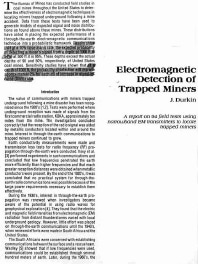Mining Publication: Electromagnetic Detection of Trapped Miners
Original creation date: February 1984
Authors: JA Durkin
The Bureau of Mines has conducted field studies in coal mines throughout the United States to determine the effectiveness of electromagnetic techniques in locating miners trapped underground following a mine accident. Data from these tests were used to generate models of expected signal and noise distributions as found above these mines. These distributions have aided in placing the expected performance of a through-the-earth electromagnetic communications technique into a probabilistic framework. Results show that at a 10% false-alarm rate, the expected probability of detecting a miner's signal from a depth of 1,000 ft is 54%; at 500 ft it is 95%. These depths exceed the actual depths of 90% and 50%, respectively, of U.S. coal mines. Sensitivity studies showed that at a depth of 1,000 ft, the probability of detection will improve approximately 2% for each decibel of increase in signal-to-noise ratio.
